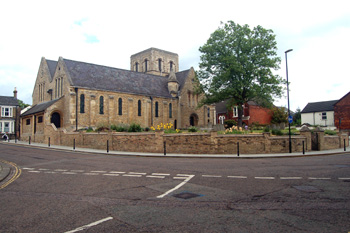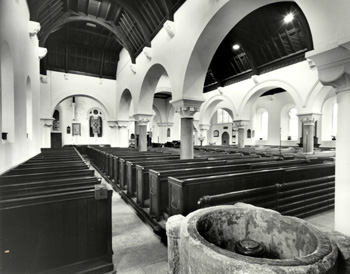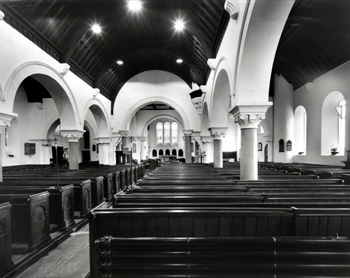
Saint Cuthbert's church seen from Castle Lane May 2009
Former County Archivist Chris Pickford wrote a series for Bedfordshire Historical Record Society on Bedfordshire churches in the 19th century, from which this article is derived.
Saint Cuthbert's church looks, superficially, as though it is a Norman building, but looks are deceiving. The present structure was built between 1845 and 1847 to the designs of Bedford architect James Woodroffe in the Neo-Norman style. The new church was consecrated on 8th July 1847.

Saint Cuthbert's Bedford interior looking west in 1974 [Z50/10/10]
The Northampton Mercury of 6th November 1847 wrote thus, in very florid terms, of the new church: "It is with sincere pleasure we returned from a visit to this church, entirely rebuilt, and in a true and right spirit. Here we can worship in all the beauty of holiness, and not amid the dirt and deformity which disgrace so many of the churches already noticed. Indeed, who that considers how much we are all affected by sensible objects, and how an appearance of outward decency and dignity promotes awe and reverence in the mind, will deny the beneficial influence which religion borrows from the solemnity and sanctity of her structures? Who has not experienced this on entering one of those sublime edifices in which genius has embodied the spirit of our holy faith, those petrifications of Christianity, as Coleridge designates our cathedrals" -
"Where bubbles burst, and folly's dancing foam
Melts if it cross the threshold, where the wreath
Of awe-struck wisdom droops".
"And in far humbler fabrics, where still a sense of the use to which they are dedicated appears at least in order, and cleanliness and decency, are we not conscious of more reverent and devotional feelings than where all is slovenly and dilapidated? What has been so well described is here felt most sensibly, more especially if the visitor should have previously seen the melancholy and degraded condition of the neighbouring church of St. Paul. It is hardly necessary to observe that the sittings are open, uniform in height, no enclosed boxes, no flaring curtains, or brazen railings, and we think the appearance this church presents will convince the most determined stickler for a separate cupboard for himself, of the great superiority and propriety of the arrangement, and happy return to the example of our forefathers".
"The view from the nave is not obstructed by reading-desk, or pulpit with its frightful appendage, the sounding board. No gallery, "the refuge of the petty aristocracy in towns, and of the disorderly in villages", rendering the church more like a theatre, closes at once the light and view of the west window".
"The organ is placed on the ground, and thus prevented from destroying, as is too generally the case, the architectural beauty of the building. The royal arms, the necessity for the introduction of which in our churches we cannot understand, and which we believe owe their appearance to a period in our history no one refers to with pleasure, are here placed in a subdued manner in the western window, and thus not rendered the most conspicuous object on our entrance into the temple of the King of kings. Where all is so good we observed with sorrow seats in the chancel. It is true they are uniform with other sittings, but, unless stern necessity demands it, their appearance is highly objectionable".

Saint Cuthbert's Bedford interior looking east in 1974 [Z50/10/11]
The church was enlarged several times. Aisles were added by the architect Francis Cranmer Penrose in 1865. In 1876 a cloister porch was added to the west end and a new organ chamber built on the north side of the chancel [P120/2/10] and the following year the new organ chamber was converted into a vestry with a new chamber being built on the south side of the chancel [P120/6/7]. A single bell, hung in 1900, replaced the bell of 1831 which had adorned the former church.

Saint Cuthbert's church west end May 2009
The church was closed in 1974 and the parish united with that of Saint Peter de Merton. The church was declared redundant on 22nd October 1975 and afterwards was used by the Serbian Orthodox community in Bedford until being taken over by the Poles of Bedford in July 1979 for use as a Roman Catholic church called the Sacred Heart of Jesus and Saint Cuthbert, which it remains to the time of writing [2009].